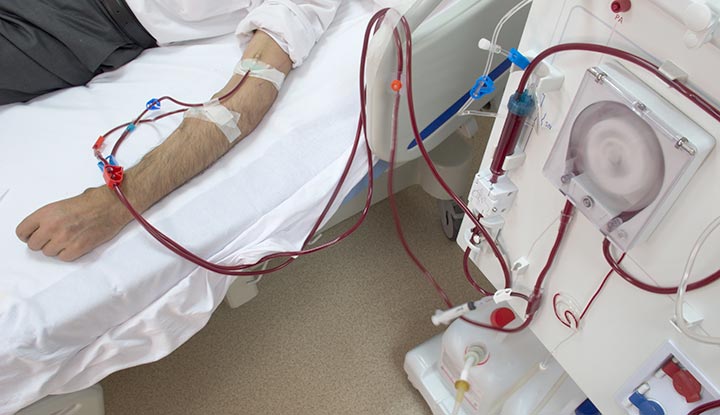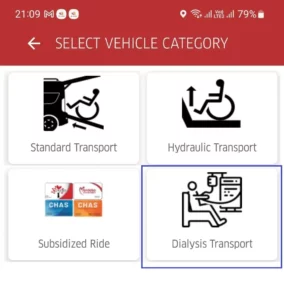Dialysis Wheelchair Transport Singapore
Message to Social Workers: We will love to assist you in providing temporary wheelchair transport for those in need. Please have your requests sent to support@vimoservices.sg Please include the day/time slots and the pickup address and the dialysis center Thank you!

What is dialysis?
Dialysis is a procedure to remove waste products and excess fluid from the blood when the kidneys stop working properly. It often involves diverting blood to a machine to be cleaned.
Normally, the kidneys filter the blood, removing harmful waste products and excess fluid and turning these into urine to be passed out of the body.
Who needs dialysis?
People who have kidney failure, or end-stage renal disease (ESRD), may need dialysis. Injuries and conditions like high blood pressure, diabetes and lupus can damage kidneys, leading to kidney disease.
Some people develop kidney problems for no known reason. Kidney failure can be a long-term condition, or it can come on suddenly (acute) after a severe illness or injury. This type of kidney failure may go away as you recover.
There are five stages of kidney disease. In stage 5 kidney disease, healthcare providers consider you to be in end-stage renal disease (ESRD) or kidney failure. At this point, kidneys are carrying out around 10% to 15% of their normal function. You may need dialysis or a kidney transplant to stay alive. Some people undergo dialysis while waiting for a transplant.
How long does the treatment last?
In some cases, kidney failure may be a temporary problem and dialysis can be stopped when your kidneys recover.
But often, someone with kidney failure will need a kidney transplant.
It's not always possible to carry out a kidney transplant straight away, so dialysis may be needed until a suitable donor kidney becomes available.
If a kidney transplant is not suitable for you – for example, because you're not well enough to have a major operation – dialysis may be needed for the rest of your life.
What are the side effects of dialysis?
- low blood pressure
- anemia, or not having enough red blood cells
- muscle cramping
- difficulty sleeping
- itching
- high blood potassium levels
- pericarditis, an inflammation of the membrane around the heart
- sepsis
- bacteremia, or a bloodstream infection
- irregular heartbeat
- sudden cardiac death, the leading cause of death in people undergoing dialysis
What is the life expectancy for a dialysis patient?
Most people can remain on dialysis for many years, although the treatment can only partially compensate for the loss of kidney function.
This means that people can die while on dialysis if they do not have a kidney transplant, particularly older people and those with other health problems.
Someone who starts dialysis in their late 20s can expect to live for up to 20 years or longer, but adults over 75 may only survive for 2 to 3 years.
But survival rates of people on dialysis have improved over the past decade and are expected to continue improving in the future.
What to expect once dialysis is stopped
Without dialysis, toxins build up in the blood, causing a condition called uremia. The patient will receive whatever medicines are necessary to manage symptoms of uremia and other medical conditions. Depending on how quickly the toxins build up, death usually follows anywhere from a few days to several weeks.
As the toxins build up, a person may experience certain physical and emotional changes. In the final days, the body starts to shut down. In most instances, the shut-down is an orderly series of physical changes which may include:
- Loss of appetite and fluid overload
- Sleeping most of the day
- Restlessness
- Visions of people who don’t exist
Disorientation, confusion, and failure to recognize familiar faces - Changes in breathing Congestion
- Changes in color and skin temperature
When do you need dialysis wheelchair transport?
One of the side effects of Hemodialysis is low blood pressure which may cause dizziness. It is safer for dialysis patients to stay in wheelchairs while traveling home.
Specialized dialysis wheelchair transport is only necessary if the patient is too weak to stand on his feet to move into a normal taxi.
What are the difference between dialysis wheelchair transport and normal wheelchair transport?
The pickup time from the dialysis center back home usually depends on how long the treatment takes, and most wheelchair transport providers do not charge waiting times for picking up from the dialysis center. It will be helpful if you can inform the driver whenever there is a delay.
How much does a dialysis wheelchair transport cost?
It is always cheaper to apply for NKF Transport subsidy. If you are not getting your treatment at NKF Branches, you may speak to social workers to apply for temporary relief for wheelchair transport, while waiting to be transferred to an NKF branch.
While waiting, you may consider VimoCare Wheelchair Transport. Our charges are $23-$60 per way. We have also introduced a specialized option for dialysis wheelchair transport with a waiting time of 30 minutes to cater for unexpected delays at the dialysis centers

